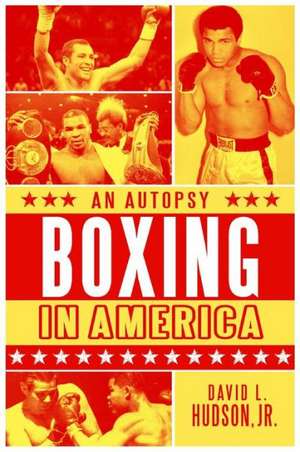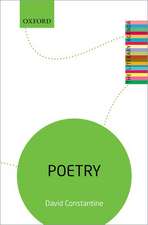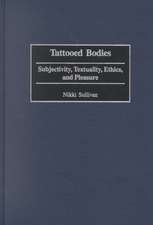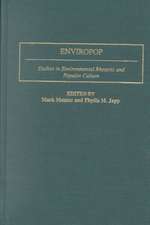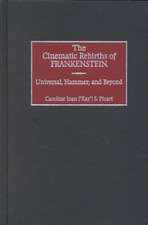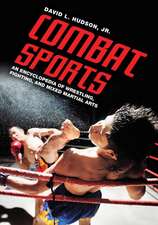Boxing in America: An Autopsy
Autor David L. Hudson Jr.en Limba Engleză Hardback – 20 iun 2012 – vârsta până la 17 ani
Preț: 355.52 lei
Preț vechi: 414.99 lei
-14% Nou
Puncte Express: 533
Preț estimativ în valută:
68.03€ • 72.75$ • 56.72£
68.03€ • 72.75$ • 56.72£
Carte tipărită la comandă
Livrare economică 17 aprilie-01 mai
Preluare comenzi: 021 569.72.76
Specificații
ISBN-13: 9780313379727
ISBN-10: 0313379726
Pagini: 216
Dimensiuni: 156 x 235 x 18 mm
Greutate: 0.5 kg
Editura: Bloomsbury Publishing
Colecția Praeger
Locul publicării:New York, United States
ISBN-10: 0313379726
Pagini: 216
Dimensiuni: 156 x 235 x 18 mm
Greutate: 0.5 kg
Editura: Bloomsbury Publishing
Colecția Praeger
Locul publicării:New York, United States
Caracteristici
Includes information from the early "bare knuckles" era of boxing up to modern-day stars and matchups, presenting the history of boxing in a chronological fashion
Notă biografică
David L. Hudson Jr. is an attorney, author, and licensed boxing judge.
Cuprins
The sport of boxing possesses a primal power that seeps into one's soul. Perhaps it appeals to innate violent instincts. Perhaps it compels attention because of its naked drama. Two men-or women-attempt to batter each other senseless, to render the opponent unconscious. For whatever reason, it creates addicts out of its aficionados, who crave another high.Think of the epic "Thrilla in Manila"-the fatalistic, fistic encounter between Muhammad Ali and Joe Frazier that concluded their trilogy. Consider "Irish" Micky Ward and the late Arturo Gatti, who waged their own trilogy-albeit on a lesser plane. Think of Jose Luis Castillo and the late warrior Diego Corrales, who beat each other senseless.No doubt, boxing suffers from certain woes. Some wish that it would be abolished as barbaric baseness. The medical community and others urge its abolition, the underworld has seized it as its own, and the greedy have sought to exploit its participants.For all its warts, boxing remains a beautiful art when practiced at its finest. There remains no more superbly conditioned athlete than a top-flight professional boxer. The best boxers-those who have mastered the science of pugilism-possess an uncanny, almost unnatural power over others. But, at its heart, the sport of boxing attracts-or demands-attention because of its brutal simplicity.It has inspired the best of writers to tap deep into their creativity. Consider that Ernest Hemingway, Jack London, Norman Mailer, and Joyce Carol Oates have committed their considerable literary talents to writing about the sport.Boxing in America: An Autopsy takes a panoramic view of the sport of boxing by covering different fighters, different eras, and different subjects. Much of the book focuses on the dominant heavyweight champions of certain time periods. There are many great fighters in the lighter weight classes, but the heavyweight champions have garnered the most attention and the most acclaim. Just as the United States Supreme Court is known by the last name of the Chief Justice-the Warren Court after Chief Justice Earl Warren-boxing often is known by the holder of the heavyweight crown. We speak of the age of Louis, the age of Ali, or the age of Tyson.John L. Sullivan-the last bare-knuckle heavyweight champion-dominates the discussion in chapter 1. The bravado, charisma, and natural punching power catapulted the "Boston Strong Boy" to fame and fortune. He became a bona fide American sports hero.Chapter 2 focuses on as compelling and divisive a subject that the United States of America ever has grappled with-the specter of race and racism. For many years, an abject color bar prevented the top black fighters from receiving their "just due"-to quote former heavyweight champion Larry Holmes. The centerpiece of chapter 2 focuses on the life of Jack Johnson, the colorful, controversial champion who inspired visceral hatred from white America.Johnson cast a long shadow over the sport of boxing, long enough that it took years for another African American to receive a shot at the heavyweight crown. Chapter 3 looks at a man who became a genuine American hero-Joseph Louis Barrow, better known as Joe Louis. The "Brown Bomber" held the heavyweight championship for more than a decade, defending his title an astonishing 25 times.Louis started a trend that continued for many years-of African Americans dominating boxing in the heavyweight division. A prominent exception was an Italian American from Brockton, Massachusetts, named Rocky Marciano (covered in chapter 4). "The Rock" never lost a professional fight, compiling a record of 49-0. He personified the 1950s, when America felt good about itself, a golden age of sorts.The 1960s were a different, more volatile time in U.S. history. The civil rights movement and the Vietnam War created a vortex of social activism unmatched in modern U.S. history. Out of this mix came a loquacious lightning rod named at birth as Cassius Marcellus Clay, covered in chapter 5. He converted to Islam, changed his name to Muhammad Ali, and became a vilified figure. This hated figure later became the most recognizable-and perhaps most beloved-figure on the planet. He truly was incomparable.Turning from the incomparable to the improbable, there perhaps is no greater comeback in the sport of boxing than that of a former champion in the 1970s who returned to the ring amid cries of ridicule in the late 1980s as an overweight preacher. This former sullen monster of a man literally transformed himself into a different person and regained the heavyweight title in the most improbable fashion at age 45. Chapter 6 tells the inspiring story of "Big" George Foreman. Chapter 7 then tells the incredible story of "Iron" Mike Tyson-a compelling if tragic figure in the sport of boxing.After examining several ages of boxing through the prism of heavyweight greats, the book turns to other serious topics. Much of the book focuses on dominant champions and top contenders. But the lifeblood of the sport, the club fighters who ply their trade without fanfare, are called journeymen. They travel to other fighters' hometowns on short notice against long odds. Most of the time, journeymen lose either legitimately or by hometown decisions. But sometimes they reach up and grab the brass ring. Prospects and champions start their career by facing these fighters. Chapter 8 highlights some of the more unusual journeymen of recent vintage in American boxing.Chapter 9 focuses on the most controversial aspect of boxing: death in the ring. Boxing inflicts punishment on its combatants in most brutal fashion. While a precious few boxers have become nonagenarians-former champion Max Schmeling lived to age 99-many have not survived brutal ring encounters. The images of a beaten Benny "Kid" Paret slumped in the corner still horrify those who saw it. Too other pugilists have met the same tragic end.Boxing and prison have had a unique relationship for many years. In prison, an inmate literally must fight to survive; the same stark phenomenon takes place in the boxing ring. Many prominent fighters learned boxing behind bars. A few even fought professionally as prison inmates. Chapter 10 focuses on one of the most mystifying characters in all of boxing history-Charles "Sonny" Liston.Finally, the book concludes with chapter 11, "The Future of Boxing and the Threat of Mixed Martial Arts." Boxing has taken a beating in recent years, while another sport-mixed martial arts-has attracted greater crowds and generated more fight cards. Mixed martial arts-particularly at the highest level in the Ultimate Fighting Championship (UFC)-have mastered the art of putting on competitive cards, matching the best fighters against each other, and avoiding the promotional tug-of-wars that sometimes afflict boxing.I am one of those souls addicted to the sport of boxing, loving it with every sinew in my body. Whether writing books about the sport or judging professional boxing bouts, I believe there is no more compelling drama in all of sports than a competitive boxing match.
Recenzii
The book has some thoughtful insights for the seasoned student of boxing and is a good starting point for newcomers to the subject. Summing Up: Recommended.
